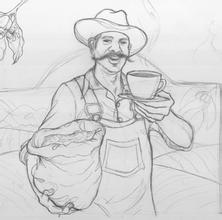Introduction to the Baking degree, Flavor description and Grinding scale of Yega Xuefei Coffee beans with strong Flavor
1) Grinding powder according to the thickness and fineness of hand punching
2) use hot water about 83-85 degrees, the ratio of powder to water is 1:15-17, and the brewing time should not be too long.
3) put the hot coffee liquid at low temperature and put it in the freezer for cold storage
In fact, this way is to put the hand-brewed coffee liquid in the refrigerator and drink it again, which is not much different from the first method, and does not need to be refrigerated for too long, so it is more suitable for people who want to drink iced coffee immediately. But there is no difference between this coffee liquid refrigerated for 10 hours and 100 hours, and it is relatively easy to play.
As for what to use with iced coffee liquid, it all depends on your own interests, even cocktails, can also use iced coffee as a base wine.
This method is one of the most frequently used by myself, all because it is simple and has a lot of ways to play.
The specific process is as follows:
Ground coffee powder can be slightly finer than hand-brewed coffee.
Pour the ground coffee powder into a bottle of distilled water or drinking water, and the ratio of powder to water can be controlled between 1:15 and 20, depending on your own taste.
Close the lid, shake the water bottle and mix the coffee powder and water well.
Put it in the freezer and refrigerate for 12-24 hours.
Remove, filter the coffee suspension and serve.
In this way, there are three main variables that can control the taste of the finished product: the fineness of the powder, the shaking strength and time, and the refrigerating time.
The finer the powder, the heavier the taste.
The harder it shakes, the longer it lasts, the heavier the taste.
Finally, cold storage time is also a very critical factor. The solubility of caffeine in water decreases as the temperature decreases, and the solubility at a temperature below 5 degrees Celsius is about 30% lower than that brewed in hot water, so if you pour coffee powder into ice water in the first place, it will make the caffeine content of the final coffee liquid lower than that of coffee brewed at high temperatures.
As for the timing of refrigeration, there are rumors that the coffee liquid will begin to ferment after being refrigerated for more than five days, but I haven't really felt anything special yet, even after seven days in the refrigerator.

Important Notice :
前街咖啡 FrontStreet Coffee has moved to new addredd:
FrontStreet Coffee Address: 315,Donghua East Road,GuangZhou
Tel:020 38364473
- Prev

The birth history of coffee roaster-Starbucks Italian roasted coffee beans
The birth history of coffee roaster-Starbucks Italian roasting coffee bean roaster, the emergence of large roasters, changed people's own baking habits, buy packaged roasted beans or coffee powder directly boiled home to facilitate the fast-paced life of modern people. In the 1960s, brand-packaged coffee beans dominated the market
- Next

Introduction of Arabica Coffee Flavor description method Grinding scale Taste production area
Arabica Coffee Flavor description treatment Grinding scale Taste production area introduction "Arabica" coffee has a variety and broad potential flavor. Arabica coffee produced in different regions, different elevations and different climates usually has its own characteristics and can show a completely different flavor. Arabica coffee smells like grass when it is not roasted.
Related
- Beginners will see the "Coffee pull flower" guide!
- What is the difference between ice blog purified milk and ordinary milk coffee?
- Why is the Philippines the largest producer of crops in Liberia?
- For coffee extraction, should the fine powder be retained?
- How does extracted espresso fill pressed powder? How much strength does it take to press the powder?
- How to make jasmine cold extract coffee? Is the jasmine + latte good?
- Will this little toy really make the coffee taste better? How does Lily Drip affect coffee extraction?
- Will the action of slapping the filter cup also affect coffee extraction?
- What's the difference between powder-to-water ratio and powder-to-liquid ratio?
- What is the Ethiopian local species? What does it have to do with Heirloom native species?

